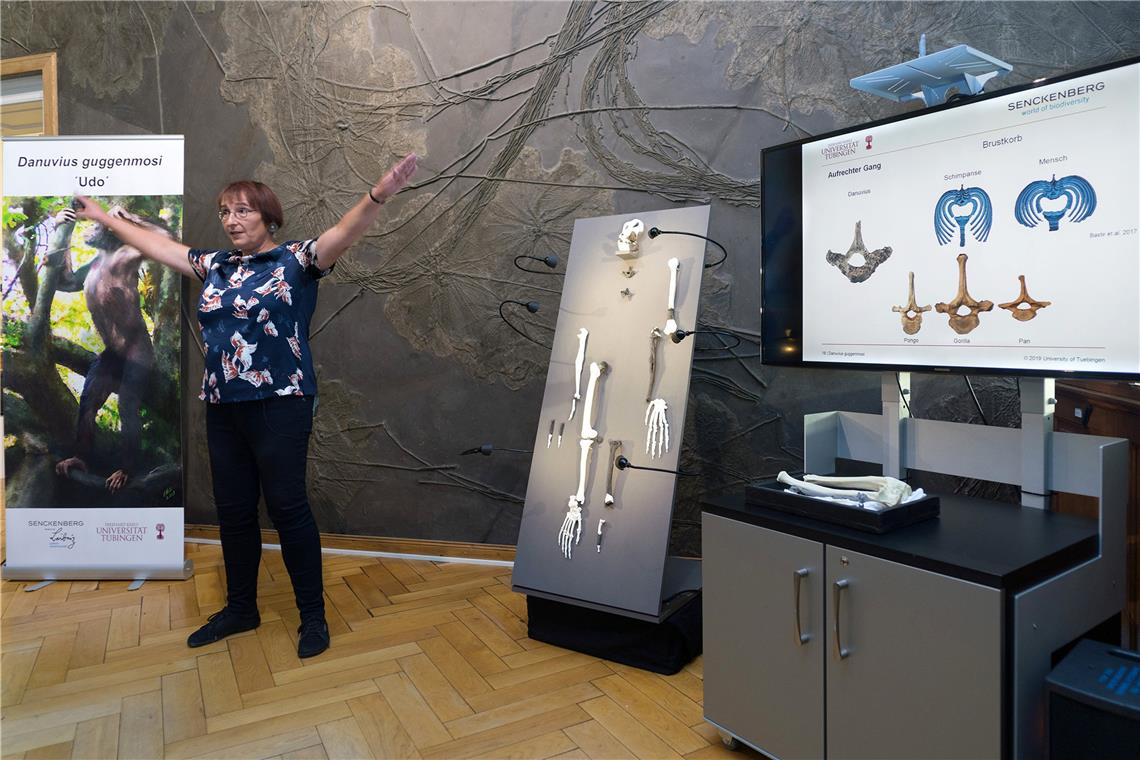11.62 million-year-old fossils discovered in the Allgäu region of Bavaria between 2015 and 2018 bear remarkable anatomic traits of both apes and early humans and may be evidence of the last common ancestor before the diversion of these species.
Danuvius guggenmosi is said to have been adept in both suspensory behaviour (the ability to hang or suspend from trees, like that of primates) and habitual bipedalism (the ability to walk on two legs like that of hominins, or early humans).
Researchers and scientists were able to reconstruct the bones of two males, one female and one juvenile in order to deduce how the species would have moved. They found that D. guggenmosi could hang from trees like modern great apes but, as its finger bones were not as robust as would be expected of knuckle-walkers, that it would have held its legs straight and walked upright whilst moving around in the tree canopy. This is due to its similar lower spine and shin bones to that of humans, and it would have walked on its soles, as shown by its grasping big toe. This unique and evolutionary transitional movement has been dubbed by scientists as “extended limb clambering”, a precursor to complete bipedalism or complete suspension.
This find is significant for a few reasons, one being that this species is potentially the common ancestral link between great apes and humans which scientists have been unable to find until now. Secondly, it may reveal that this common ancestor may in fact have lived in Europe, not Africa, as previously thought. And lastly, the find may have just pushed back the timeline for bipedalism.
There are many theories that exist to explain how humans became bipeds: some argue that it was to adapt to the changing environment of the Savannah due to a loss of forests, some argue that it was to adapt to being able to carry food or make tools, and others say it was in order to better disperse body heat in a changing climate. Nevertheless, the early human skeleton began to change overtime, the spine became vertical with two curves, the pelvis became more bowl shaped to adjust to locomotion changes and in females, bigger infant brain and head size at birth meant pelvises became wider.
In the late 1900s, scientists began to make new discoveries and started to form an evolutionary timeline. The first on this timeline were “Australopithecines,” including Australopithecus afarensis and Australopithecus africanus, who lived 4-3 million years ago and 3-2 million years ago respectively. Lucy is the best-known example of A. afarensis, as her skeleton showed what was then the first evidence of bipedalism. She had a skull akin to a chimpanzee, but below her neck, the anatomy of her spine, pelvis, hips, thigh bones and feet, were typical of bipeds. “Robust Australopithecines” came next, with A. robustus and A. bosiei, who both roamed Africa around 2-1 million years ago. Then, during a rapid period of change, Homo habilis emerged around 2 million years ago as the earliest evidence in the genus “Homo”. A couple hundred thousand years later and the official first human ancestor, Homo erectus walked the earth between 1.9 million and 140,000 years ago. They were the beginning of a migratory species and began to adapt to different weather conditions around the world. Then came Neanderthals and early Homo. sapiens, genetically shown to have interbred, and finally modern H. sapiens.
Throughout the timeline, evolution can be primarily tracked through bipedalism, a reduction of the face, teeth and jaws, and an increase in cranial capacity. Understanding not only how we came to walk on two feet, but how we came to be as intelligent as we are as a species today, will hopefully help scientists to answer many of the big questions surrounding the evolution of our species.
More research into this new find, D. guggenmosi and how it fits on the evolutionary timeline, will help us to understand more of our own lineage and the lineage of our closest relatives.
image source: https://www.tagblatt.de/Nachrichten/Erster-Fussgaenger-war-Schwabe-435490.html

